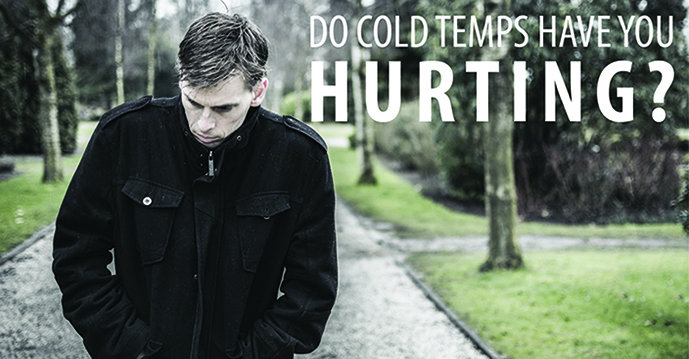In many parts of the country, we are in the throes of winter’s cold weather. If you are not a winter sports enthusiast (I am not), you probably are yearning for longer days and warmer temperatures. For many people, cold weather is more than inconvenient; it causes a very real increase in pain.
Whether you have a chronic, systemic condition, a long-standing orthopedic problem, or just the aches and pains that come with aging, cold weather can magnify the associated pain. But why? It is unlikely that there is a singular cause but rather several contributing factors.
A quick Internet search reveals all sorts of proposed causes: barometric pressure, a decrease in muscle and tendon elasticity with decreased temperatures, decreased blood flow to the joints, and even seasonal affective disorder.
I tend to believe that the answer lies primarily in the functioning of the human nervous system. That alone, or even in conjunction with one or several of the other theories out there, constitutes a plausible explanation in the absence of any conclusive scientific proof.
THE NERVOUS SYSTEM EXPLAINED
Let’s try to make something that is infinitely complex very simple:
The nervous system is the body’s own information superhighway. It carries and processes every single sensation (good or bad) that we experience. The peripheral nerves carry impulses (activity) through the spinal cord to the brain; it is the brain’s job to interpret the information it receives.
If the peripheral nerves functioned in an on-or-off manner, every single thing that happened to us and around us would be carried to our brains for processing. That amount of constant information and stimulation would be too much for our brain to handle. Instead, our nervous system functions on more of a threshold system. So any input first must reach a certain level of activity before being transmitted to our brains for processing.
Our body even has a way of accommodating or fine-tuning that threshold. Think of it this way: When you put pants on in the morning, you are aware that they are on and how they feel. You notice quickly whether they are soft or the material is coarse. You sense whether they are tight or loose.
In a short period of time, your nervous system accommodates those sensations, and you move about your day without being constantly aware of how your pants feel. So, in effect, your nervous system raises the threshold of stimulus required for you to sense that your pants are even there. Even though the fabric texture nor the fit have changed…so there is still input, or activity…you are no longer focused on the sensation.
Input can be from various sources and can be cumulative. The latter can exceed the nervous system’s threshold, resulting in a sensation being transmitted to the brain for interpretation.
Back to our pants example: Let’s say you put on a pair of light, loose-fitting pants. You quickly accommodate to the sensation and are barely aware of wearing them. Now, you walk outside and the wind is blowing. The wind makes your loose-fitting pants flap back and forth against your legs. You now are more aware of what your pants feel like, right?
The fit and texture of your pants plus the movement created by the wind result in a stimulus that exceeds your nervous system’s threshold, thus sending a sensation (or maybe several) to your brain. Your brain then interprets this activity as the sensation of your pants against your skin.
SO, WHAT DOES THAT HAVE TO DO WITH COLD WEATHER AND PAIN?
Pain input or activity can vary greatly. If you smash your thumb with a hammer, you immediately exceed your nervous system’s threshold, sending an impulse to your brain that quickly is interpreted as “Ouch!” Pain input also can be present at a sub-threshold level.
Maybe the input is not great enough to exceed the threshold, causing you to only sense pain, or maybe your body has accommodated to the sensation and fine-tuned the threshold so that more input is required before you sense pain. Either way, it may only take a small amount of additional input for your brain to interpret the now cumulative input as pain.
Well, cold most certainly can serve as that additional input. If you have an arthritic joint, fibromyalgia, or any other of various conditions, the sub-threshold stimulus may be ever-present. Various things can add to that level of activity — cold temperatures, for sure — and combine to exceed the threshold that results in your brain interpreting the sensation as pain.
WHAT CAN YOU DO ABOUT IT?
Assuming that you can’t pack up and head to the Caribbean, there are simple techniques that can help to “down regulate” or control the activity of the nervous system. This could help to decrease pain any time of year but most certainly could be effective in this situation.
If the cold weather makes your painful condition worse, it may be worth seeking the input of your physical therapist to see how he or she might help.

